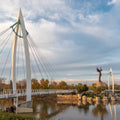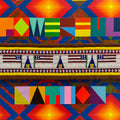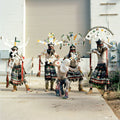Acts of Faith: Religion in the American West
By Chadd Scott on
How did religion become a vital and contested part of American life?
That’s the question, and for the answer, the New-York Historical Society Museum & Library looked West. It considered Native peoples, Protestant missionaries, Mormon settlers, Catholic communities, African American migrants, Jewish traders, and Chinese immigrant workers.
It pushed beyond the mythologized “Wild West” of popular culture and found a fuller and surprising picture: a West populated by preachers, pilgrims, and visionaries, home to sacred grounds and cathedrals that kindled spiritual feeling from the woodlands of New York all the way to the valleys of California.

C.C.A. Christensen (1831–1912), 'Crossing the Mississippi on the Ice,' ca. 1878. Tempera on muslin, 77 78 x 114 in. Brigham Young University Museum of Art, gift of the grandchildren of C.C.A. Christensen, 1970
“Religion served as a source of identity, a driver of settlement, a force of social organization and control, and a resource for resistance and resilience,” Vice President for History Exhibitions at New-York Historical Society Marci Reaven said.
When taking on a subject as broad, deep, varied, and all-encompassing as the role of religion in America’s westward expansion, that’s as succinct a summation as any available.
Reaven co-curated NYHS’s “Acts of Faith: Religion and the American West,” an exhibition exploring the interplay between religion and U.S. expansion in the 19th-century with the aim of illuminating how religion came to assume its central and controversial role in American life. The West Side of Manhattan seems like a strange place to answer one of the fundamental questions about the vast American West.
“Interestingly, New-York Historical's museum and library collections are pretty rich in materials connected to the West and to religion,” Reaven explained. “With this as an inspiration, we hit on the idea of looking at religion during the 19th-century heyday of U.S. expansion and conquest, which was an important time of nation building and self-definition. It struck us that in our previous exhibits about topics central to the idea of ‘We the People,’ we had never before focused on religion. Given religion's importance in our history and culture, and the groundbreaking nature of American protections for religious liberty, we thought this (exhibition) would be a useful and exciting contribution. We began to contact scholars in U.S. western history, religious studies, and Native studies, and they excitedly encouraged us to bring this story out of the history books into wider circulation.”

Apache Girls on Arrival at the Ramona School, Santa Fe, N.M.' The Ramona School for Indian Girls Santa Fe, N.M., 1886 Patricia D. Klingenstein Library, New-York Historical Society
On view through February 25, 2024, “Acts of Faith” displays art, artifacts, and objects illustrating the critical role played by religion in American westward expansion.
“U.S. expansion in the 1800s increased religious heterogeneity, but also intensified public and private attempts to bring about homogeneity. The contests over how to manage religious differences in the West forced participants to grapple with what religious liberty across a diverse continent would mean in practice,” Reaven said. “Whose religious liberties would be protected and how would competing concerns be handled? These conflicts altered the landscape of religious practice and freedom in important ways. Today's debates over topics like protection for sacred spaces and funding for religious schools make clear that the issues explored in ‘Acts of Faith’ are ongoing.”
Religious Inequality
Whose religious liberties would be protected in the West came with a flip side: whose would not?
Not surprisingly, the religious practices of America’s Indigenous population were no more valued or respected by an ever-growing horde of colonizers and an expanding government than were Indigenous land claims. Fundamental to any understanding of America, of religious freedom and persecution in this country, of its foundations in white supremacy and Christian nationalism, and the lengths to which the country went in its efforts of cultural genocide against Native people, understand that it was illegal for Native Americans to practice their religion and ceremonies until 1978.

Apache Girls Six Days after Arrival at the Ramona School,’ in The Ramona School for Indian Girls Santa Fe, N.M., 1886. Patricia D. Klingenstein Library, New-York Historical Society
If you’re an American over 45-years-old as of 2023, you have lived in an America that withheld First Amendment rights, by law, from Native people.
“Congress shall make no law respecting an establishment of religion, or prohibiting the free exercise thereof.”
Except for Native Americans up until 1978.
“Native peoples across the continent faced the question of how to defend their present and future as they struggled to protect their homelands, lives, and cultures from Euro-American colonization,” Reaven said. “We start the exhibit in the East—then the stronghold of the United States—as both citizens and governments pressured Indigenous nations to cede their territories and move west. Native leaders drew on all available resources, including spiritual powers, to challenge U.S. aggression.”
Examples of this are shared in the exhibition.
“In the early decades of the century, Haudenosaunee and Pokagon Potawatomi peoples called upon prophecies, traditions, and religious alliances to contend with the pressures of removal,” Reaven said. “In mid-century, after their violent removal to Indian Territory (today's Oklahoma), displaced Cherokee people looked to their longstanding values to reunite their nation and rebuild harmonious relations in a new land. In the 1880s and '90s, Lakota peoples fought to perform their annual Sun Dance ceremony, resisting the U.S. government's ban on Native religious practices promulgated by the 1883 Code of Indian Offenses.”
That was the legislation which forbade the Sun Dance, Ghost Dance, potlatches, practices of medicine persons, and other forms of Indigenous spirituality. The Code “gave Indian agents authority to use force, imprisonment, and the withholding of rations to stop any cultural practices they deem immoral or subversive to federal government-mandated assimilation policies.”
Denial of the First Amendment.
Christians and whites faced no such impediments in expanding, let alone practicing, their beliefs.
“In the 1820s and '30s, interdenominational Protestant missionary groups based in New York City and led by people like Rev. Lyman Beecher organized a massive initiative to imprint the new territories and all who lived there with their faith,” Reaven said. “Within just four years, they sent nearly 300,000 Christian tracts (pamphlets) and four million Bibles to western settlers in the Mississippi Valley. They also sent 330 ministers and established 1200 Sunday schools. The First Amendment prevented the U.S. government from evangelizing the settlers, so these ordinary Americans—believing that they were saving the Republic—organized to ensure that Protestantism would spread throughout the West along with expansion.”
Catholicism, too.
“Another story drawn from the exhibit focuses on the work of then-Bishop Jean Baptiste Lamy and the Sisters of Loretto to sustain and standardize Catholicism in lands that had been Mexico, but were now the U.S. Southwest,” Reaven added. “They were sent there by the Roman Catholic Church immediately following the US-Mexico War (1848) and the creation of the huge new diocese of Santa Fe. Among their ambitious, often contested, efforts, they started a system of Catholic schools and built Santa Fe's St. Francis Cathedral in a European style.”

Chong Hou Tong bone repatriation book, 1903. China Alley Preservation Society, Hanford, CA. Restored and digitized by Tung Wah Museum, Hong Kong
Bone Repatriation
Among the exhibition’s highlights are Robert Weir’s portrait of the famous Seneca chief Sagoyewatha, or “Red Jacket;” a bulto (wooden statue) of San Ysidro Labrador from 19th-century New Mexico; and an emigrant trunk labeled “From Basel to Salt Lake City, Utah” that belonged to a convert to the Church of Jesus Christ of Latter-day Saints.
Nothing proves more fascinating, however, than a bone repatriation book.
“Bone repatriation was a cultural practice of many of the Chinese immigrants who arrived in California during and after the Gold Rush,” Reaven explains. “Its adherents found peace in knowing that, should they die away from home, their bones, bearing their spirits, would be exhumed and returned to China. Reburied among family, their spirits would be cared for.”
“Acts of Faith” displays a rare book produced by San Francisco's Chong Hou Tong benevolent society documenting four campaigns between 1863 to 1897 to collect and repatriate the bones of dead workers from remote graveyards, mines, and railroad construction sites throughout the West. The China Alley Preservation Society in Hanford, CA has done the important work of preserving and caring for this document.
One quote from the book is, "The dead were many, and their graves were scattered. Some of these places were on high mountains, and some were in deep valleys. Still, the team managed to carry out their mission. With such effort and dedication on the part of the living, surely the dead can rest in peace."
“The exhibit not only shares information about bone repatriation, but also explains how Chinese immigrants sought to defend their values and practices against charges of heathenism and punitive California laws that sought to stop bone repatriation,” Reaven said. “Such accusations of heathenism contributed to the attitudes that led to passage of the 1882 Chinese Exclusion Act—the first U.S. immigration restriction based on race and class.”
America’s prohibition on Chinese immigration would stand for more than 60 years. Another story of the West for another day. =



